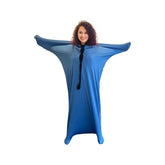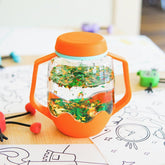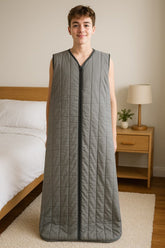Trending Now
Popular Products
Sensory Body Sock
- from £18.99 (£22.79 inc VAT)
- from £18.99 (£22.79 inc VAT)
- (-0%)
- Unit price
- / per
Glo Pals Sensory Jar
- £19.49 (£23.39 inc VAT)
- £19.49 (£23.39 inc VAT)
- (-0%)
- Unit price
- / per
-
Purple
-
Blue
-
Yellow
Fledglings Bodyworn Sleepsuit
- from £73.99
- from £73.99
- (-0%)
- Unit price
- / per
-
Grey
-
Blue
-
Pink
Need Help?
Email Us
- Christmas
- Clothing
- Swim
- Sensory & Activities
- Sensory & Activities
- All Sensory
- Activity Items
- Best Selling
- Guides & Advice
![]()
- Learning
- Daily Living
- Daily Living
- All In The Home
- Best Selling
- In The Home Guides & Support
![]()
- Toileting
- Bedtime
- Out & About
- Teens+
- Condition
- Brands
- Help
- Help
- Help
Bibs & Neckerchiefs: Practical Advice
Bibs and neckerchiefs can make day-to-day life easier by keeping clothes dry, protecting skin, and supporting dignity at home, school and when out and about. With the right fit and fabric, they can be discreet, comfortable, and easy to care for.
Safety note: Always supervise if a child chews or mouths fastenings. Follow manufacturer guidance for age suitability and care. If you have concerns about swallowing or persistent skin irritation, seek clinical advice.
Who this can help
- Children and young people with constant dribble/drool or reflux
- Those with low tone, reduced lip closure or oral-motor differences
- Anyone who needs extra protection during mealtimes, therapies or travel
- Adults who prefer dignified, scarf-style options rather than traditional bibs
Quick wins
- Choose the right layer stack: absorbent front + waterproof (or water-resistant) backing for heavier dribble.
- Prioritise comfort: soft fabrics against the skin; avoid scratchy seams/labels near the neck.
- Fit first: measure neck circumference and pick a fastener that suits (press studs/poppers, hook-and-loop, or pull-on).
- Plan spares: keep a small rotation (school bag, car, bedside) to change quickly when damp.
- Care made easy: choose wipe-clean or quick-dry fabrics for school/clinic use; wash routinely to protect skin.
Products that can help
Start with these ranges, then pick items that fit age, setting and budget.
-
Bibs & Neckerchiefs – everyday protection, bandana/scarf styles for discretion, and larger tabards for fuller coverage.
- Care Designs PRO80 Junior Tabard Style Bib — high-coverage tabard with absorbent front and wipe-clean backing; junior sizing for better fit.
- Dignified Clothing Protector — discreet, smart look for teens/adults with waterproof-backed protection for everyday wear.
- Mum 2 Mum Plus Back Opening Clothing Protector — back-opening design for easier changes and adjustable, comfortable fit.
- Mealtime Aids – plates/bowls that aid scooping; adaptive cutlery
- Drinking Aids – handled cups, controlled-flow and cut-out cups to support safer sipping
Choosing the right bib or neckerchief
1) Fabric & layers
- Absorbent fronts (e.g. cotton, bamboo, fleece) help wick moisture away from the skin.
- Waterproof/repellent backs (e.g. PUL/TPU, coated backing) stop soak-through onto clothing.
- Wipe-clean finishes are handy in clinics, school and mealtimes where frequent cleaning is needed.
2) Fastenings
- Press studs/poppers: secure, durable, less likely to catch hair.
- Hook-and-loop: widely adjustable and quick to remove; check it doesn’t irritate the neck.
- Pull-on/stretch collars: no fasteners; useful for those who remove bibs frequently.
3) Size & coverage
- Neck circumference: measure snugly where the fastening sits; allow for comfort.
- Drop length: from collarbone to where you want the protection to end (e.g. upper chest or mid-torso).
- Width/shoulders: wider styles help with side dribble or when seated in buggies/wheelchairs.
4) Style & dignity
- Scarf/bandana neckerchiefs look like everyday accessories and can match school uniform colours.
- Tabards/aprons offer maximum coverage for mealtimes, art and cooking.
- Night-time options use soft, absorbent layers that stay comfortable when lying down.
Care & hygiene
- Have enough bibs for your wash cycle (e.g. daily change + spares).
- Follow the product’s care label; wash at the recommended temperature and fully dry before reuse.
- Check stitching, bindings and fasteners regularly and replace if worn.
- For sensitive skin, change damp bibs promptly and keep the neck area clean and dry.
Troubleshooting
- Soaking through quickly: move to multi-layer or waterproof-backed options; increase change frequency.
- Skin redness/irritation: switch to softer inner fabrics; wash more frequently; ensure the bib isn’t rubbing.
- Pulling bibs off: try alternative fastenings or scarf-style designs; consider pull-on collars.
- Velcro catching hair: try poppers or ensure hook-and-loop edges face away from hair/skin.
Funding & budgets
- Potential funding options for families
- Digital catalogues to compare options by category
Need advice?
Email enquiries@fledglings.org.uk with age, setting (home/school/clinic) and how many changes you need per day. We’ll suggest options that fit your budget. We accept Purchase Orders. UK delivery from £4.99.
Support our work
Donate to Fledglings to help us keep advice free and prices fair.
Related
Last reviewed: 11 September 2025
- Choosing a selection results in a full page refresh.








